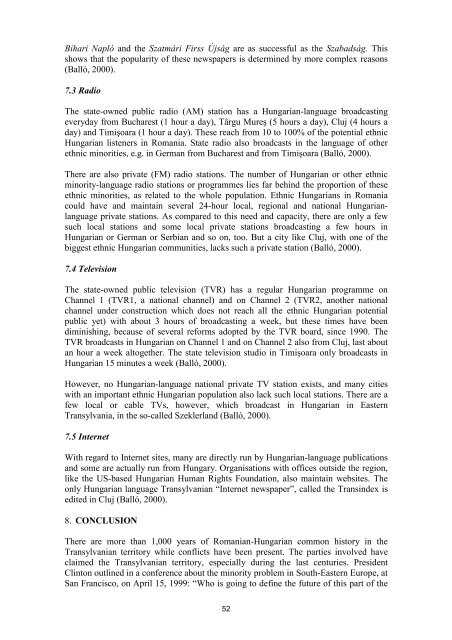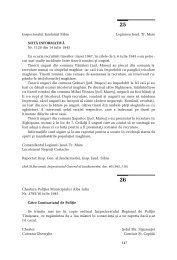Southeast Europe
Southeast Europe
Southeast Europe
Create successful ePaper yourself
Turn your PDF publications into a flip-book with our unique Google optimized e-Paper software.
Bihari Napló and the Szatmári Firss Újság are as successful as the Szabadság. This<br />
shows that the popularity of these newspapers is determined by more complex reasons<br />
(Balló, 2000).<br />
7.3 Radio<br />
The state-owned public radio (AM) station has a Hungarian-language broadcasting<br />
everyday from Bucharest (1 hour a day), Târgu Mureş (5 hours a day), Cluj (4 hours a<br />
day) and Timişoara (1 hour a day). These reach from 10 to 100% of the potential ethnic<br />
Hungarian listeners in Romania. State radio also broadcasts in the language of other<br />
ethnic minorities, e.g. in German from Bucharest and from Timişoara (Balló, 2000).<br />
There are also private (FM) radio stations. The number of Hungarian or other ethnic<br />
minority-language radio stations or programmes lies far behind the proportion of these<br />
ethnic minorities, as related to the whole population. Ethnic Hungarians in Romania<br />
could have and maintain several 24-hour local, regional and national Hungarianlanguage<br />
private stations. As compared to this need and capacity, there are only a few<br />
such local stations and some local private stations broadcasting a few hours in<br />
Hungarian or German or Serbian and so on, too. But a city like Cluj, with one of the<br />
biggest ethnic Hungarian communities, lacks such a private station (Balló, 2000).<br />
7.4 Television<br />
The state-owned public television (TVR) has a regular Hungarian programme on<br />
Channel 1 (TVR1, a national channel) and on Channel 2 (TVR2, another national<br />
channel under construction which does not reach all the ethnic Hungarian potential<br />
public yet) with about 3 hours of broadcasting a week, but these times have been<br />
diminishing, because of several reforms adopted by the TVR board, since 1990. The<br />
TVR broadcasts in Hungarian on Channel 1 and on Channel 2 also from Cluj, last about<br />
an hour a week altogether. The state television studio in Timişoara only broadcasts in<br />
Hungarian 15 minutes a week (Balló, 2000).<br />
However, no Hungarian-language national private TV station exists, and many cities<br />
with an important ethnic Hungarian population also lack such local stations. There are a<br />
few local or cable TVs, however, which broadcast in Hungarian in Eastern<br />
Transylvania, in the so-called Szeklerland (Balló, 2000).<br />
7.5 Internet<br />
With regard to Internet sites, many are directly run by Hungarian-language publications<br />
and some are actually run from Hungary. Organisations with offices outside the region,<br />
like the US-based Hungarian Human Rights Foundation, also maintain websites. The<br />
only Hungarian language Transylvanian “Internet newspaper”, called the Transindex is<br />
edited in Cluj (Balló, 2000).<br />
8. CONCLUSION<br />
There are more than 1,000 years of Romanian-Hungarian common history in the<br />
Transylvanian territory while conflicts have been present. The parties involved have<br />
claimed the Transylvanian territory, especially during the last centuries. President<br />
Clinton outlined in a conference about the minority problem in South-Eastern <strong>Europe</strong>, at<br />
San Francisco, on April 15, 1999: “Who is going to define the future of this part of the<br />
52









